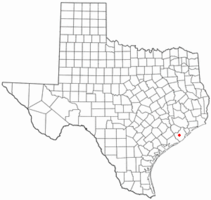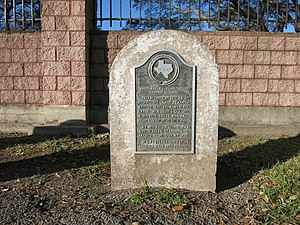Bailey's Prairie, Texas
Bailey's Prairie, Texas | |
|---|---|
 Location of Bailey's Prairie, Texas | |
 | |
| Coordinates: 29°9′29″N 95°29′28″W / 29.15806°N 95.49111°W | |
| Country | United States |
| State | Texas |
| County | Brazoria |
| Area | |
| • Total | 7.20 sq mi (18.65 km2) |
| • Land | 6.99 sq mi (18.09 km2) |
| • Water | 0.21 sq mi (0.56 km2) |
| Elevation | 30 ft (9 m) |
| Population (2010) | |
| • Total | 727 |
| • Estimate (2019)[2] | 773 |
| • Density | 110.65/sq mi (42.72/km2) |
| Time zone | UTC-6 (Central (CST)) |
| • Summer (DST) | UTC-5 (CDT) |
| ZIP code | 77515 |
| Area code | 979 |
| FIPS code | 48-05288[3] |
| GNIS feature ID | 1351418[4] |
| Website | baileysprairie |
Bailey's Prairie is a village in Brazoria County in the southeastern portion of the U.S. state of Texas. The population was 727 at the 2010 U.S. census. Established in 1818, the village is named for the pioneer James Briton "Brit" Bailey (1779-1832).[5][6]
Geography
Bailey's Prairie is located in central Brazoria County at 29°9′29″N 95°29′28″W / 29.15806°N 95.49111°W (29.158084, -95.491051).[7] Texas State Highway 35 runs through the town, leading east 5 miles (8 km) to Angleton, the county seat, and west 8 miles (13 km) to West Columbia.
According to the United States Census Bureau, the village has a total area of 7.7 square miles (19.9 km2), of which 7.5 square miles (19.3 km2) is land and 2.2 square miles (5.8 km2), or 2.90%, is water.[5]
Demographics
As of the census[3] of 2000, there were 694 people, 237 households, and 201 families residing in the village. The population density was 92.4 people per square mile (35.7/km2). There were 244 housing units at an average density of 32.5 per square mile (12.5/km2). The racial makeup of the village was 80.84% White, 14.12% African American, 0.86% Native American, 0.14% Asian, 0.43% Pacific Islander, 2.02% from other races, and 1.59% from two or more races. Hispanic or Latino of any race were 10.09% of the population.
There were 237 households, out of which 35.4% had children under the age of 18 living with them, 77.6% were married couples living together, 6.3% had a female householder with no husband present, and 14.8% were non-families. 13.1% of all households were made up of individuals, and 4.6% had someone living alone who was 65 years of age or older. The average household size was 2.93 and the average family size was 3.18.
In the village, the population was spread out, with 26.4% under the age of 18, 7.8% from 18 to 24, 24.4% from 25 to 44, 33.9% from 45 to 64, and 7.6% who were 65 years of age or older. The median age was 40 years. For every 100 females, there were 104.1 males. For every 100 females age 18 and over, there were 98.8 males.
The median income for a household in the village was $73,125, and the median income for a family was $90,648. Males had a median income of $47,083 versus $29,609 for females. The per capita income for the village was $32,267. About 1.9% of families and 4.3% of the population were below the poverty line, including 2.6% of those under age 18 and 4.9% of those age 65 or over.
| Census | Pop. | Note | %± |
|---|---|---|---|
| 1970 | 228 | — | |
| 1980 | 353 | 54.8% | |
| 1990 | 634 | 79.6% | |
| 2000 | 694 | 9.5% | |
| 2010 | 727 | 4.8% | |
| 2019 (est.) | 773 | [2] | 6.3% |
| U.S. Decennial Census[8] | |||
Education
Bailey's Prairie is zoned to schools in the Angleton Independent School District.
History
According to The Handbook of Texas, Bailey had been living in Texas for several years before Stephen F. Austin's Old Three Hundred original families arrived. Born in North Carolina in 1779, Bailey was married at a young age, and the couple had six children. After his first wife died, he married her sister, Hannah, and fathered five more children.
Bailey moved to Kentucky and apparently served in the Kentucky House of Representatives. Supposedly, he was prosecuted for forgery before he left the state. He next lived in Tennessee and fought in the War of 1812, after which he headed to Texas to settle land that would later become part of Brazoria County, specifically Bailey's Prairie.
Bailey allegedly bought his land from the Spanish government. After Mexico won its independence from Spain however, the Mexican authorities refused to recognize his claim that the land belonged to him. Bailey would not give up his home even though Austin ordered him to leave. Though Bailey and Austin apparently disliked each another, Austin recognized Bailey's squatter's claim to the land. He was given a league and a labor of ground on the east bank of the Brazos River and was commissioned as a captain in the local militia. At that time, Texans were loyal Mexican citizens, and Bailey took the oath to defend the Mexican Constitution of 1824.
Bailey gained a reputation as a troublemaker, one who regularly engaged in brawls and was evidently a constant thorn in Austin's side. He died of cholera on December 6, 1832.
-
James "Brit" Bailey Historical Commission marker
-
Munson Cemetery Historical Commission marker
-
Bailey Plantation Historical Commission marker
-
Munson Cemetery on Texas State Highway 35
Popular lore
Brit Bailey's ghost
The highway which connects Angleton and West Columbia and runs through Bailey's Prairie is supposedly haunted by the ghost of James Briton "Brit" Bailey. According to legend, the ghost, carrying a lantern, roams across the flat land of Brazoria County at night in constant search for a jug of whiskey which was to have been buried with Bailey.
The ghost appears as a bouncing white ball of light floating about four to six feet off the ground. Many claim to have seen this phenomenon known as "Bailey's Light," but no one knows its cause. The light has been known to "chase" vehicles travelling on the highway late at night or in the early morning hours.
In his will, Bailey demanded that he be buried standing upright and facing west. According to legend, he also wanted his rifle at his side and the jug of whiskey at his feet. The slaves who dug his grave were said to have stolen the whiskey. Other versions of the legend maintain that his wife, Hannah, threw the jug of liquor in the field so that it would not be buried with her husband, which would have been an affront to God.
Media
The actor Paul Fix plays Bailey in the 1969 episode "Here Stands Bailey" of the syndicated television series Death Valley Days, hosted by Robert Taylor not long before Taylor's own death. In the story line, Bailey and Hannah (Rosemary DeCamp), make their final settlement in Texas and have overcome many obstacles over the years. Now they face the arrival of Stephen F. Austin (John Carter), who orders them off the land. However, Austin has a change of heart and asks them to stay in recognition of their pioneer hardiness. In accordance with his will, Bailey is buried standing upright facing west, hence his grave marker reading, "Here Stands Bailey Facing West."[9]
References
- ^ "2019 U.S. Gazetteer Files". United States Census Bureau. Retrieved August 7, 2020.
- ^ a b "Population and Housing Unit Estimates". United States Census Bureau. May 24, 2020. Retrieved May 27, 2020.
- ^ a b "U.S. Census website". United States Census Bureau. Retrieved 2008-01-31.
- ^ "US Board on Geographic Names". United States Geological Survey. 2007-10-25. Retrieved 2008-01-31.
- ^ a b "Geographic Identifiers: 2010 Demographic Profile Data (G001): Bailey's Prairie village, Texas". U.S. Census Bureau, American Factfinder. Archived from the original on February 12, 2020. Retrieved April 17, 2014.
- ^ "Bailey's Prairie, Texas". Texas State Historical Association. Retrieved 2012-02-06.
- ^ "US Gazetteer files: 2010, 2000, and 1990". United States Census Bureau. 2011-02-12. Retrieved 2011-04-23.
- ^ "Census of Population and Housing". Census.gov. Retrieved June 4, 2015.
- ^ "Here Stands Bailey on Death Valley Days". Internet Movie Data Base. February 18, 1969. Retrieved July 13, 2015.





